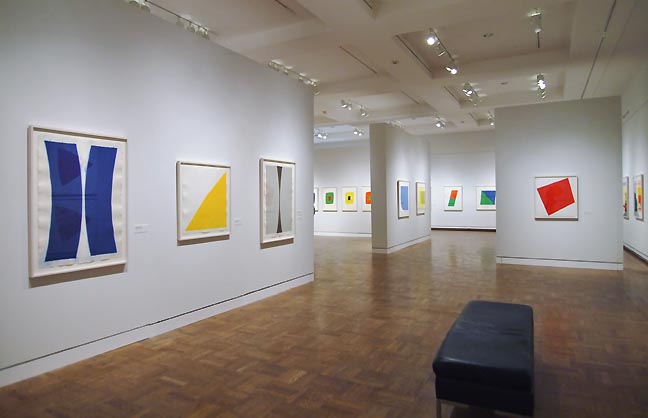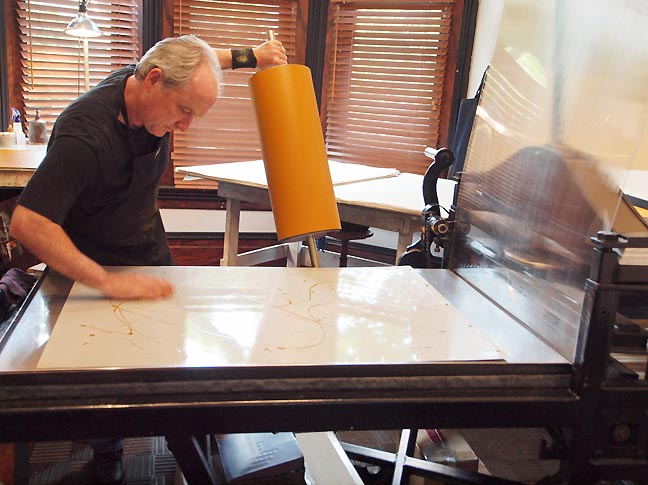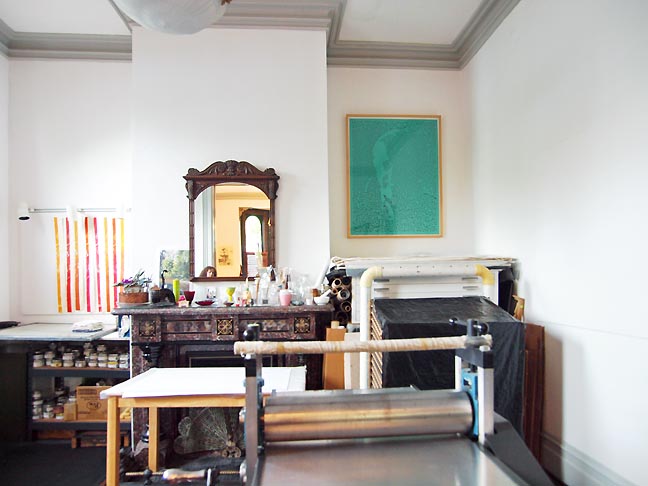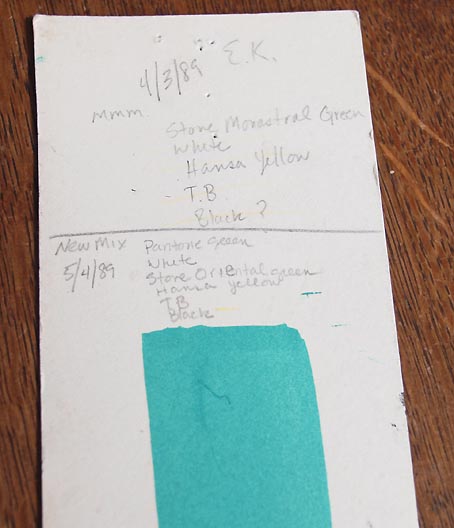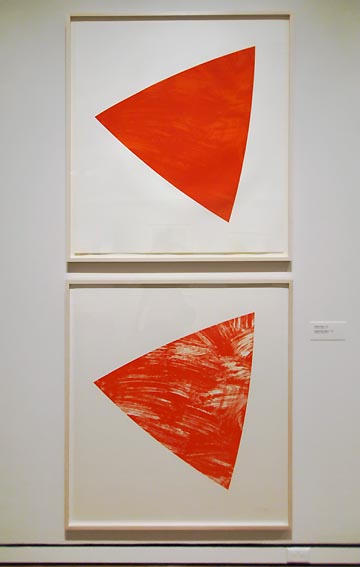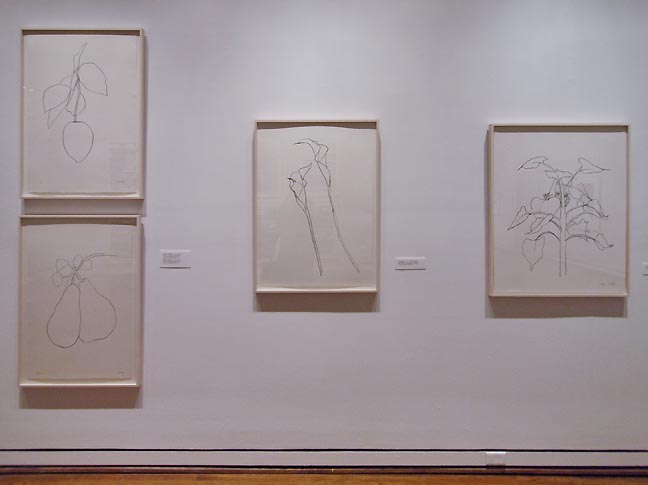
|
||
|
Portland art blog + news + exhibition reviews + galleries + contemporary northwest art
|
||
Working with Ellsworth, an interview with Mark and Rae Mahaffey
Ellsworth Kelly is the world's greatest living abstract painter and the extensive show of his prints on view right now at the Portland Art Museum details just why. Part of the exhibition's greatness is the way it exudes the generous charm of the sublime, not unlike a sunset on the beach or a baby's smile. It's hard to believe that simple line and color can be so powerful, but it is and bears up well under close scrutiny where slight variations in form or color can matter so much. The exhibition itself is a slightly different version of LACMA's critically received show and everyone should take this viewing opportunity, which presents so much depth and breadth from a single artist. It is a perfect summer show. For some, abstraction has reputation for being remote and inaccessible but Ellsworth's generous line and color are anything but. The color has such character that it alone reminds me of a warm greeting from family. The lines are sharp, playful and equally generous like the embrace of an old friend. Instead of sentinels of projected power his forms are in fact distillations of personal memory and experience. In fact, all of the forms are sourced from real life, first carefully observed, then captured in photos and lastly distilled until nothing but the form transforms Ellsworth's own personal subjective experience into something more universal. It is as if Kelly has taken an Epicurian impulse (it is obvious he knows something about enjoying life) and somehow found a way to make into a distillate that others can translate with their eyes. Thus, Kelly is perhaps single-handedly responsible for showing how formal work need not follow Clement Greenberg's doctrine of material handling/form as content. The lesson that it isn't the material but the final message... in this case, one of gracious reception and reciprocity, which made Kelly the lynchpin of Dave Hickey's 2001 art world shattering Beau Monde exhibition at Site Santa Fe... the exhibition that made beauty worthy as a subject again. His prints carry that spirit in a way that is perhaps even more approachable than the paintings and sculpture and we thought the occasion of his exhibition, culled from Jordan Schnitzer's vast collection was a great excuse to talk to Portland's very own master printer Mark Mahaffey and his wife Rae about what it was like to work with the man. (This probably wont be the last of PORT's coverage either.)
Mark Mahaffey: Yeah in 1989 I was hired away from Tyler to work for Gemini GEL. His (Ellsworth) was actually the first project I worked on at Gemini, the portrait series. It was a lot of fun to work on and he was a lot of fun to work with. He's quite the colorist, very specific about his color and he came in with color swatches like many of the artists they have their own pallets and it is just a matter of matching those colors and coming out and producing a body of work quickly for him. Mainly there is one collaborator that was Jim Reid and then three satellites which were Ken Farley, myself and Claudio Stickar. Those satellites have two or three people with them and the body of work was brought in. These were his portraits. He was doing something a little bit different as he had taken some candid shots of his friends and family. He blew those pictures up over and over again on a xerox machine until he got it to the scale he wanted it to be. I kind of reminded him of his experience during WWII in the army when he was in charge of camouflage so this was one of the things he was thinking about, how he was breaking up these images.
JJ: Because he has subject matter or at least source material that his work always springs from. I think a lot of people might just think they are arbitrary shapes but they are always sourced from some observation that he distills into those forms. RM: I hadn't realized until we worked with him that he worked photographically... that his work is almost always pulled as a source from photographs and here is a picture of how long ago it was. MM: It's Bill Murray! (describing himself with laughs) So we started off by printing the black and white pieces, just to get his approval an them. And then from there we went onto printing color backgrounds. JJ: (paging through a file) his color is so specific oh and this is so great "Company secrets, copy of copies... can I photograph this?"
JJ: and is that because it is sharper or starker as a litho? MM: Just a different surface quality to it RM: He really was concerned with the surface because it would have been easier to do a screen print MM: More cost efficient because what happens on a lithograph is the roller "laps" so they had to create a huge roller. (shows me a picture) Obviously it takes two people to print with because it weighs about 60 lbs. In this case we had a team of three and one person would go back and communicate with the head and they would communicate with Ellsworth. I know at the end that Ellsworth was really pleased with the color so that was kinda nice a very fun personable guy to work with. JJ: His work has always struck me as exceptionally generous as if the colors and forms weren't withholding a lot of information or a kind of privileged or esoteric code like some abstract artists. Also his attention to surface is available to the eyes... it isn't smoke and mirrors. It is very direct. MM: it is very direct but that is what makes it very difficult to print. (pointing to an image of a print in the show) This is over 96 inches and this is printed first then this is printed next and you want to make certain that when you get down to the end here that you are not printing a boomerang. Also, we even made it more difficult by printing color first on some of the portraits then printing black on top of it. You are right they are easy but quite difficult... without smoke and mirrors. He was very particular, if he saw a little gap or something was off he'd kill the print. Even with the green one they would just staircase stack them but if he saw any shift in between the editions they would get pulled. JJ: Did he speak much about the difference between the paintings and the prints? The general consensus on the paintings is that they are more exterior and the prints are more interior. Or put it this way did he focus much on the printed edge as a way to heighten the interior aspect? MM: Not that much, really he was more concerned about the color and about getting the image large enough to where it broke up and pleased him. I always thought that his portraits were his fun work and he had about 5 different types of prints that he would make. He had portraits, Botanical work, geometric, rivers and he did collages too so these (portraits) were more of his fun work representing his friends and family. RM: This predates us at Gemini and represents more of where he was concerned about the blank space around the printed image (18 colors from 1981). Because of the demand the started picking and choosing who they would sell it to... if it was an institution then they would sell it. How did he get that texture on the fans? Because he really didn't want to see the hand was it a squeegee?
RM: I remember the one with the converse tennis shoe's pattern... but that was Jim Reid on that. MM: I was there for four years and the Portraits was the only project I worked on. A lot of these projects would take 2-3 years each. RM: I remember him coming and going a lot. MM: We saw him and Jack (Shear) all of the time. They were always coming in to check things and they were always working on new pieces. They would start discussing a project way before printing and the shop would make certain that the space and the printers were available to scale up production for whatever was going to happen. They were probably hoping that it would be a silk screen project because that would take a lot less people to do that kind of work. JJ: Kelly's work is demanding and has a great deal of integrity. If that approach also puts a bunch of print makers to work as well, then all the better. MM: For each of the artists they would say come in and they (Gemini) would open everything up but at some point they would try to narrow the process. They wouldn't show the artist all 36 flavors once they started down a particular direction. RM: On some of those huge Spectrums that Ellsworth did storage became a problem, even with Gemini's huge flat files and you still couldn't store those things. MM: Things would sit on tables and then they would become tables themselves as more boards were put on top of them and things would just keep piling up. Even to this day I'm certain that there are things that are not completed, just because they dont have the people to do it. RM: Yeah Jim (Reid) said there aren't the lithographers. MM: Most good printers are intaglio or relief printers and they don't have a lot of lithography background so I don't know what they are going to do there.... hire us all out for a summer of love and let's get it done. JJ: That's the thing about Ellsworth Kelly's prints, it is a mechanical production oriented process so it is an natural extension of his interests in the quality of form and color and not like some artists who make prints just because of the money. In many ways the paintings are one off prototypes and the prints are a small production run that comes after. Kind of like Ferraris, you have the race cars as development prototypes then the very limited street legal ones.
JJ: It's important to get these things down and at least retell them for the historical record. MM: And as far as the difference between the prints and the paintings... The paintings must be comparatively more private, with just Ellsworth and maybe a few assistants working on them. RM: I thought it was interesting in reviewing this in that he works in the reverse of most artists in that the prints follow the paintings, instead of the other way around. Like that print Dana (Schutz) did which then was developed into a painting. Because Ellsworth kinda revisits his paintings in the prints. MM: I never heard him say “working on a painting” when he was working on his prints JJ: that says it all, you can just tell he is the sort of artist who only gives his undivided attention.
Posted by Jeff Jahn on August 29, 2012 at 11:17 | Comments (0) Comments Post a comment Thanks for signing in, . Now you can comment. (sign out)
(If you haven't left a comment here before, you may need to be approved by
the site owner before your comment will appear. Until then, it won't appear
on the entry. Thanks for waiting.)
|
| s p o n s o r s |
 |
 |
 |
 |
 |
 |
 |
 |
 |
 |
 |
 |
 |
 |
 |
 |

|
Site Design: Jennifer Armbrust | • | Site Development: Philippe Blanc & Katherine Bovee | |


